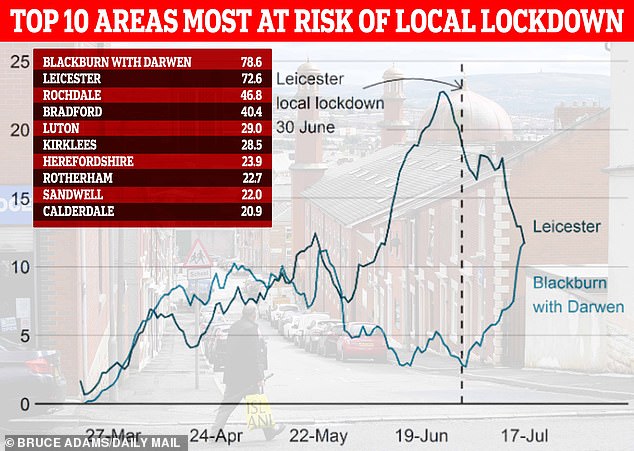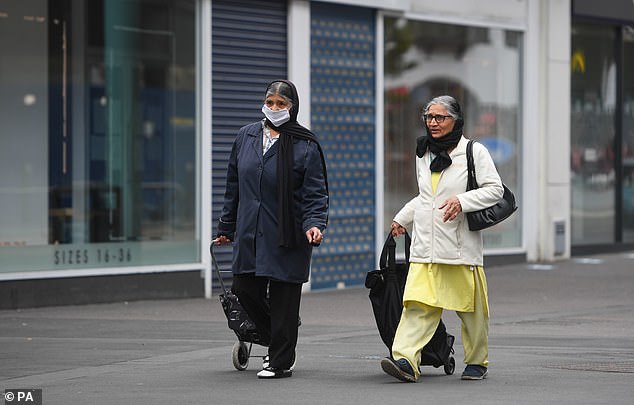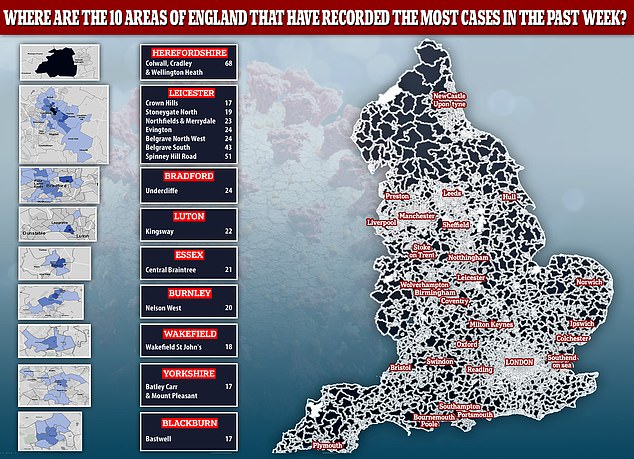NHS Test and Trace is failing in areas with high BAME populations because of ‘language barriers and trust issues’, experts warn
- In Luton just 47 per cent of potentially-infected people contacted by tracers
- Only 65 per cent of close contacts in Leicester ere tracked down and isolated
- A language barrier may be one of the driving factors behind low success rates
NHS Test and Trace is still failing to track down up to half of Covid-19 patients’ contacts in areas most at risk of local lockdowns, it emerged last night.
Experts say language barriers are one of the main factors behind the low success rates, as many of England’s worst-affected areas have high numbers of residents from black, Asian and ethnic minority (BAME) backgrounds.
In Luton, which has the fifth highest infection rate in England, just 47 per cent of potentially-infected people were contacted by the system since its launch on May 28.
A fifth of the population in the Bedfordshire town do not speak English as their first language, according to Statista.
Only 65 per cent of close contacts in Leicester – which had to retreat back into lockdown last month after a spike in cases – were tracked down by tracers.
It means 3,340 people who may have had the disease in the city slipped under the radar and could have spread it further through the population. For more than a quarter of people in Leicester (27.5 per cent), English is not their native language.
Scientists have repeatedly warned contact tracing systems need to catch and isolate 80 per cent of potential Covid-19 patients to keep the epidemic squashed.
Professor Paul Hunter, an epidemiologist at the University of East Anglia, told MailOnline: ‘The language barrier certainly will have been an issue, people might not necessarily understand what the tracers are asking or why it is important they hand over contact information.’
Gabriel Scally, professor of public health at the university of Bristol and a member of ‘Independent SAGE’, said this breakdown in communication had led to a breakdown of trust.
He told MailOnline: ‘People from BAME groups make up a high proportion of the populations in many of these cities and towns. For many, English is not their first language. This leads to communication and trust issues.
‘The Government should devolve contact tracing powers locally to people who understand their communities, and the cultures within them, better. On a regional level it’s easier to involve communities in the whole case finding and isolating process.’
Local councilors and public health officials are now demanding more control over the test and trace process on the back of the ‘very concerning’ figures.
They say devolving power to local authorities could allow them to do door-to-door visits if contacts cannot be reached by other means.

NHS Test and Trace is still failing to track down up to half of Covid-19 patients’ contacts in areas most at risk of local lockdowns (top ten, shown)

People walk through the centre of Leicester, where localised coronavirus lockdown restrictions have been in place since June 29. Only 65 per cent of close contacts in Leicester were tracked down by tracers
An interactive map which breaks down Covid-19 cases by postcode allows people in England to monitor infection rates in their neighbourhood
The data, obtained by the Guardian, looked at contact tracing results from between May 28 and June 17.
It revealed thousands more potential patients in other areas of England with rising infections were being missed by the system.
A total of 984 close contacts in Kirklees, West Yorkshire, were not tracked down, meaning a third of potential patients (33 per cent) are unaware they might have the disease.
In Rochdale, Greater Manchester, 759 contacts weren’t reached by tracers, which accounted for more than four in 10 suspected patients.
For Blackburn with Darwen, which is being kept under review amid a surge in infections, at least 448 people were missed (46 per cent).
The government’s Scientific Advisory Group for Emergencies (SAGE) has said the system must aim to reach 80 per cent of close contacts and get them isolated within 72 hours for the programme to work.
Executive Chair of NHS Test and Trace, Dido Harding, has admitted in the past that the system has faced issues such as language barriers and working schedules which prevented people from answering the phone.
‘There’s a lot we are doing to improve it,’ she said, ‘We are calling up to 10 times a day for one individual.
‘We have increased our translation services, we have included multiple languages including sign language.’
Local leaders reacting to the findings are now demanding the Government let them take more control of the system because they have the community ties to be able to hunt down contacts on a street level.

The most up-to-date data released by the Government shows Colwall, Cradley and Wellington Heath in Herefordshire was the worst-hit place in England, recording 68 new cases between July 6 and 12. The next four worst-hit middle super output areas — small geographical areas used for statistics — were all in Leicester
NHS Test and Trace, in its current state, sees tracers bombard contacts with texts, emails or phone calls up to 10 times a day.
Gerry Taylor, Luton borough council’s director of public health, said she was ‘very concerned’ at the low rate in her town and blamed the centralised system for being too far removed from communities.
She told the Guardian: ‘Clearly 47 per cent is too low. The bulk of the contact tracing feels somewhat distant from us and working more closely together with the national system I think would be a huge advantage.’
Kate Hollern, the Labour MP for Blackburn,added: ‘People are out there spreading the virus unknowingly due to this government failure.
‘The responsibility and resources for this should have been with local government, who have the local knowledge. It’s a complete shambles and we really need to get control of it.’
Bradford council, which is also being kept under review amid rising cases, declined to provide Test and Trace figures, but admitted ‘a high number of contacts’ were being missed by the national programme.
A council spokeswoman told the newspaper she was urging the Government ‘to allow us to set up a local extension to the national test-and-trace system which would enable us to follow up uncontacted data with door-to-door visits, something which no national system can really do.’
A Department of Health and Social Care spokesperson said: ‘NHS test and trace has already helped test and isolate more than 180,000 cases – helping us control the spread of the virus, prevent a second wave and save lives. This represents 81% of close contacts identified by those who test positive.
‘The service is working closely with local authorities across England to help manage local outbreaks. High quality data is critical to providing good public services and we’ve been providing increasingly detailed data to local directors of public health, helping them tackle local outbreaks and control this virus.’
Health bosses last week released an interactive map breaking down new coronavirus cases by postcode in an effort to keep a lid on local outbreaks.
The map of England, which is updated each week, paints a clear picture showing the Covid-19 crisis in cities, towns and even small villages being hit hard by the virus.
Pressure had been mounting on the Government to be more transparent about rolling Covid-19 data in local areas, to prevent other towns and cities being hit by local lockdowns.
It was accused of not sharing the data quickly enough with public health officials in Leicester, which was forced to revert to lockdown on June after a spike in cases.
The public are able to access the interactive map themselves to gain insight into Covid-19 cases near their home. But it is not possible to identify individuals by name and address.
Local public health bosses in each region will also be given positive test data and contact tracing figures each day after mounting pressure on officials to provide more data intelligence.
Leicester mayor Sir Peter Soulsby has been fiercely critical of the ‘blanket’ restrictions placed on the whole city — which still has the highest infection rate in the country.
He believes locking down specific neighbourhoods in the city which are particularly badly-hit by Covid would be a less economically crippling way to tackle the disease.
